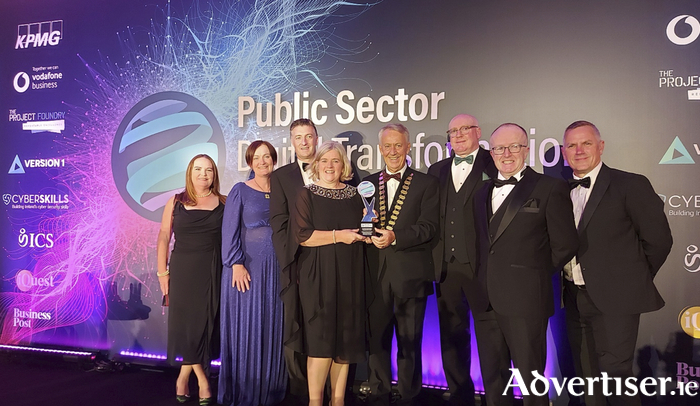Galway County Council has picked up one of the main accolades at the Public Sector Digital Transformation Awards 2023 for its innovative digital project that mapped over 40,000 graveyard memorial records across County Galway and made them publicly available online.
The Digital Mapping of Graveyards Project was named overall winner of the ‘Best Community Engagement’ category of the competition at a ceremony held in Dublin’s Shelbourne Hotel last week.
Organised by The Sunday Business Post, the awards recognise the achievements of public sector organisations that have made significant contributions to advancing digital transformation across Ireland. Galway County Council beat off competition from a shortlist of organisations that included Dublin City Council in partnership with Trinity College Dublin, CAWT and Aurion Learning, Longford County Council and Tipperary County Council to win the top award.
Working with and supported by Galway Rural Development, Forum Connemara, The Heritage Council, The National Monuments Service and Galway County Community Archaeology Service, Galway County Council provided funding to local groups to employ experts to train local communities to use mobile technology and to undertake drone mapping of graveyards resulting in a public release of 40,000 records from across the county via the Local Authority’s Open Data Portal.
Cllr. Liam Carroll, Cathaoirleach of Galway County Council, said the success of the Digital Mapping of Graveyards Project has been years in the making and is the result of forensic research and cutting-edge surveying work by the Local Authority’s Heritage department and local communities across Galway. This has resulted in a body of work that will be of benefit to the diaspora and academia at home and abroad for years to come.”
Liam Conneally, Chief Executive of Galway County Council added that in congratulating everybody involved, he wished to emphasise the significance of the award win for the future development of this innovative project and similar digital projects that seek to record, preserve and share details of Galway heritage for the benefit of future generations.
“In an effort to digitalise our services Galway County Council has begun the preparation of a Council Digital Strategy and I am happy to say this is the first instalment of this progress. I am delighted to confirm that it is proposed to transfer and update more memorial records and to map graveyards and record further memorial inscriptions in the coming months and years.”
Eileen Ruane, Director of Services, Human Resources, Environment, It and Digital Transformation, Galway County Council, said that Galway County Council, through its GIS team, has identified the capability of advanced technology to record Galway’s rich heritage in a way that makes it accessible to a much wider audience, as well as providing a valuable resource for researchers and academia. “We are immensely proud of our achievement and look forward to developing existing and new projects into the future.”
According to Marie Mannion, Heritage Officer for Galway County Council, the aim of the project is to support the diaspora and communities to connect with their past by unlocking valuable graveyard information and making it available as open-source data that is free to use.
“We are delighted with the positive reaction we have received to making the records publicly available online and this national award will inspire us to further expand the project and develop similar heritage-based digital projects.”
As part of the project, Connemara West mapped seven graveyards in Ballinakill Parish, Renvyle, Tooreena, Salrock, Letterfrack Boys Cemetery, Banogues, St Thomas and Ballinakill.
Janet O’Toole of Connemara West said the project’s success is the result of dedicated volunteers giving over their time, and expert guidance delivered by the County Heritage Officer, Marie Mannion with her team in the County Council.
“We have mapped seven graveyards in this area, and they are now part of this bigger project from the local authority. It’s online and anybody can enter their surname to find where their ancestors are buried.”
Outlining the background to the project, Barry Doyle, Geographic Information System (GIS ) project lead for Galway County Council, said they have been working with various community groups and organisations to collect and collating valuable data relating to those who are buried in various graveyards for several years.
“Galway County Council, with funding from the Heritage Council, the Open Data Engagement Fund and its own resources developed and made available a mobile app specifically for use by surveyors at the local level for memorial surveys, along with associated data management and validation processes.
“This technology, along with drone technology, was made available to local community groups to expand the number of graveyards in the project resulting in the 40,000 records that are now publicly available.”
The Galway County Digital Mapping of Graveyards Project may be viewed at galwaycoco.maps.arcgis.com and data.gov.ie

